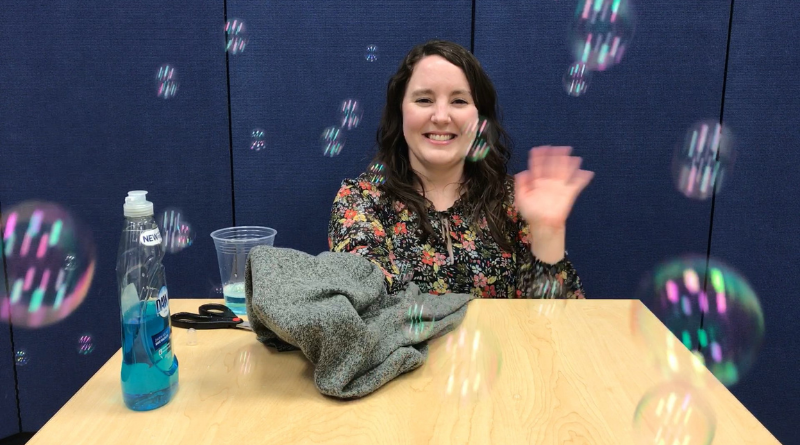
Discovery Time: Bubbles
Join us for Discovery Time! Enjoy hands-on activities that introduce STEAM concepts that are just right for preschoolers. STEAM stands for science, technology, engineering, art and math. Your child’s creativity, curiosity and persistence make them natural scientists. Science and art encourage your child to explore and investigate their world by observing and experimenting. Early math and reading skills often overlap, too.
The desire to read is an important factor in your child becoming a skilled reader. If your child is interested in a particular topic, read books that focus on that topic. You can apply their interests to early learning activities as well. Bubbles are a fun activity for any child that will reinforce visual tracking, hand-eye coordination and more.
Supplies:

For bubble solution:
- Small cup
- Water
- 3 tablespoons dish soap
For bubble wand:
- Plastic pipette;
- Chopsticks and thick tread, wire or cord;
- Pipe cleaner; or
- Straw
Other supplies:
- Soft/fluffy towel or soft glove
- Scissors
Procedure:
To make your bubbles:
- Fill a cup with water, about 1/3 full.
- Add 2-3 tablespoons of dish soap.
- Mix the water and soap together. You may need to experiment with how much water and soap you add to create the perfect bubble solution.
To make a pipette bubble wand:
- Use scissors to cut part of the bulb (the large end) of the pipette off.
- Dip the end that was cut into the bubble solution.
- Blow through the small end (the stem) to create bubbles. This part of the procedure is the same if you are using a straw.
To make a chopsticks and thread bubble wand:
- Break the chopsticks apart, if attached.
- Cut one piece of thick thread, wire, or cord, 8 inches long.
- Cut a second piece of thick thread, wire, or cord, 12 inches long.
- Tie both pieces to the ends of the chopsticks.
- You may need to attach something, such as a washer, to the longer piece in order to weigh it down.
- Dip the bubble wand in the solution and slowly pull the wand away.
- Wave the wand around slowly to create bubbles.
To make a pipe cleaner bubble wand:
- Bend one end of the pipe cleaner into a small circle shape.
- Leave the other end of the pipe cleaner straight to create a handle for the bubble wand.
- Dip the wand into the solution and blow to create bubbles.
To catch a bubble:
- Blow a bubble and try to catch it with your hand. What happened? Were you able to catch it, or did it pop?
- Now try blowing the bubble so that it lands on a soft towel. What did you observe? What happened to the bubble?
- Put a soft glove on one of your hands and blow a bubble onto the glove. What happened? Were you able to catch the bubble?
This activity introduces the science behind bubbles and why they pop when they touch our hands but may not if they touch a soft towel or glove. This introduces basic science concepts such as chemistry, surface tension and elasticity.
Blowing bubbles is a great way to develop visual tracking skills in small babies and hand-eye coordination in older children. Blowing bubbles also strengthens the lips and mouth in toddlers that are used to form word sounds. All of these skills will strengthen your child’s reading and writing skills later in life.
The early literacy activities you do today will set your child up for a successful tomorrow. Playing together is always a great way to learn!
Books:
- Bubble Bubble by Mercer Mayer
- Gilberto and the Wind by Marie Hall Ets
- Pop!: A Book about Bubbles by Kimberly Brubaker Bradley
- The Nature and Science of Bubbles by Jane Burton



